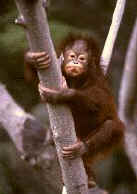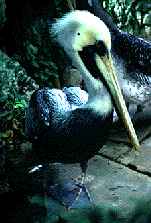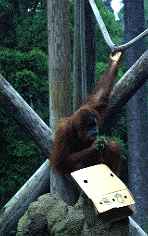HELP FOR ENDANGERED SPECIES AT SUPER ZOOS AND AQUARIUMS
by Louis BignamiToday's super zoos do much more than display animals. Bars are out; releases of zoo raised animals to the wilds are in, and there's better viewing than ever before.
Thirty years ago, when I passed the cages and paddocks that held a rather limited assortment of mostly California animals at Oakland's Knowland Zoo, endangered species were very low on the priority list. Zoos displayed a dispirited collection of animals and birds in cages and other small enclosures. Even so, I remember the San Francisco Zoos' spitting monkey and the rather tattered African antelopes at the Bronx Zoo. However, it's with considerably more pleasure that I recall the wonderful bird collections in the Saint Louis Zoo Bird House, the happy captives in San Diego's Zoo and other exhibits seen in 25 years of travel writing.
Zoos started early. Wen Wang, a Chinese Emperor, built a 900-acre walled zoo back in 1100 BC. Nebuchadnezzar had a zoo in Babylon; Roman Emperor Trajan's zoo held over 10,000 animals. Various English Kings ran zoos in the Tower of London and these led to the now somewhat outdated, but still wonderful, Regent's Park Zoo in 1826. Zoos have served some strange purposes too. Hernado Cortez reported that Aztec Emperor Montezuma fed criminals to his zoo's animals. Cortez did not fancy this "uncivilized" practice. Apparently, he forgot the Romans' habit of feeding lions with spare Christians.
American zoos, which mostly opened in the second half of the 19th Century, followed the European tradition of urban animal display. Things started changing with the Endangered Species Act of 1973 when the rate of loss of the world's animals and birds became most evident. Many species had lost so much habitat to man that they were nearly extinct in the wild. So the 150+ member, American Association of Zoos, Parks and Aquariums, an organization that once strove for the Victorian ideal of "one of" individual or "species family" collections, started the Species Survival Plan which began to improve genetic variety and insure the survival of endangered species. They hope to have 200 of these plans up and running by the year 2000. So zoos shuffled their animals into larger groups that, in combination with the move away from barred enclosures, improved reproduction rates. Where nature was not so disposed, man used artificial insemination, embryo transfer, in vitro fertilization and simpler techniques, like hatching eggs of endangered birds in the lab or under a handy chicken. As a result, today's zoos offer more than their wonderful natural exhibits. They keep endangered species going and, in some cases have started putting endangered animals like the Arabian Oryx back into the wild. This last requires the animals have armed guards!
Your zoo admission supports much of this. Most zoos get 50% or so of their budget from taxes. The San Diego Zoo's a happy exception that's within 5% of self-supporting -- but the visitor dollar is increasingly important to maintaining these programs. Since this is the case zoos, more than ever before, offer better value for the tourist and local dollar coast to coast. Here's my doubtless prejudiced list of the ten best zoos and aquariums in America.
You will notice the list omits SeaWorld, MarineWorld Africa USA and the like that, while worthy organizations, seem a bit more dedicated to entertainment than to education or conservation. Nothing wrong with that; it's certain that traditional zoos and aquariums move towards entertainment as their public funding dries up just as the above attractions move towards conservation and education as they realize this is good business, as well as a good ideal. Eventually, there will be a merger, but in the meantime I have a crass personal prejudice against animals that do tricks for their dinner.
San Diego Zoo
Along with its "separate, but at least equal" Animal Park, the San Diego Zoo is my personal favorite. To start, the weather's usually wonderful, and I am a sucker for Koalas -- the zoo has a lot of these cute "Teddy Bears." But, I would rather spend time with the gorillas and the pygmy chimpanzees. The Tropical Rain Forest's a dandy place to hide from midday heat with the tigers and a flock of colorful birds.

It's always "hug a tree" day for Australia's best ambassadors.
PHOTO CREDIT: ANNETTE LUCIDO
The Malayan Honey Bears got my wife's vote as the best bears ever, but when she brought me back to see them, they had hidden out after lunch. That's the price you pay for realistic exhibits that may require a little more time to see than the old-fashioned bare concrete cages of years back.
However, one of the more interesting exhibits, the hummingbirds, is missed by most visitors who, lured by the colorful Flamingos head into the zoo or cut to the right to the dozens of koalas. So "go left, go left!" As a bird nut, I never miss the aviary, and cannot wait to see the new Australia rain forest complex. I am not a fan of the tram, however, and I would suggest you bring a picnic from downtown and enjoy al fresco dining as you watch the koalas.
San Diego Wild Animal Park
We could see the park from my wife's uncle's house, so we visited often in the 1980's. Today it's even better as a special photographer's bus tour or the WGASA monorail takes you past 2,500 animals that include roaming elephants and other veldt species. There is an interesting story not for a family publication about how the WGASA got its name: so ask.
This is one spot where you can see many endangered species like California Condors, oryx or wonderfully colorful Sumatran tiger, and at least 3,000 plant species. My wife loves the monkeys too. However, this may be the best place in the country to "get bugged" at the summer insect shows. About 500 butterflies a week hatch here and live out their short lives. If you like showoff animals you will find bird and animal shows and assorted rides.
Cincinnati Zoo & Botanical Garden
A great place for rhinos and wonderful for bugs of all sorts, the Cincinnati Zoo also offers a red panda and much else. Their Butterfly Aviary and Insect World show you why "bugs" make up the majority of the world's species. The leaf-cutter ants and honeybee exhibits are must-see and you will learn more than you may want to know about butterfly feeding with sugared water via an eyedropper. The zoo has done a dandy job breeding tigers and gorillas and, in particular, black rhinos. The botanical side of things is well designed and focused on American and other temperate species.
New England Aquarium
Centered about its 80-foot, 187,000-gallon Caribbean tank and offering a cool break with the penguins on hot summer days, this splendid aquarium has one of the best exhibits of octopuses in the world. The Caribbean tank reminds me of Bank Island in the U.S.Virgins, a famous undersea park. The dolphin show outside deserves a look even though Andre, the seal who used to hang out all summer and then commute back to Cape Anne in the fall, is no more. Best of all, you can get there on one of Boston's wonderful subways, the Blue Line.
National Zoological Park
While a lot of the very important breeding programs go on at Front Royal Virginia which is not open to the public, there is enough here to justify a two day visit. Try to arrive early because the zoo opens at eight in the summer. Then run, do not walk, to the panda. Hsing-Hsing or his successor panda have not done well in American zoos. His mate, Ling-Ling died in 1992 here.
The highlight here, as elsewhere is a jungle exhibit. The NZP's covers the Amazon ecosystem. World wide, rain forests have lost 40% of their trees in 20 years and could lose the rest in another 50. The Amazon Gallery offers a close up look at what we would miss.
Brookfield Zoo
Chicago's zoo ranks in the top five -- higher if you share my love for snow leopards. The nocturnal cats exhibit -- many cats are just that -- rates as the best in the US. A three section Tropic World shows off South American, Asian and African delights such as two-toed sloth or colobus monkeys. A highlight of any visit is the 800,000-gallon "dolphinarium" with its 2,000 seats. You get a better view through the underwater viewing windows even though it's not certain whether you, or the dolphins, are most entertained. Exhibits for children like "Be A Bird" are better than usual. Shedd Aquarium in Chicago is a close runner up to our three as well.
National Aquarium in Baltimore
While the Boston Aquarium offers a nearby visit to the Constitution, Baltimore's got its lesser-known sister ship, the Constellation. Both craft deserve a visit. So do the dozen wonderful theme exhibits and the many lesser attractions. The Atlantic Coral Reef Exhibit's our favorite as you walk down inside the five-story tank.

"Pity the Pelican whose bill can hold more than his belly can."
Ogden Nash
PHOTO CREDIT: ANNETTE LUCIDO
There's a penguin exhibit -- Seaworld's are better -- and the oceanarium's marine mammal show is worth scheduling. Do not eat in the museum though; there are lots of better spots for the heartless to enjoy seafood delights such as blue crab here, there and everywhere around the harbor.
Bronx Zoo, AKA International Wildlife Conservation Park
I have not figured out what's what with the New York Zoological Society's various zoos, islands and breeding operations. This won't surprise anyone who follows some of the funding fights between the Society, city, state and others that one official said, "resemble Russian politics." I suspect the fact that the naked mole rats in the nocturnal life exhibits are, in large part, named after Board of Trustees members, says something about zoo politics. 
Did you know monkeys, and other zoo animals, sulk when the zoo's closed? Entertainment runs both ways.
PHOTO CREDIT: ANNETTE LUCIDO
But Bronx Zoo has to be one of the top three or four in America. This goes back for years, but today's zoo seems best expressed as contemporary Jungle World, which is unarguably the best single zoo exhibit in America. Numbers do not express its scope. It's got 1,000,000 cubic feet of heavily forested, misty space backed by waterfalls to display over 500 animals of at least 80 species. I have spent time in the jungle in Central and South America. This is as close as you get without biting bugs. It even smells right.
Just across the river via the Bengali Express monorail you will find Wild Asia with Indian and Asian species. However, the World of Birds, as usual, gets my attention first, last and, with a detour to see the Tropical Bird House, always. Tip: bring a snack and sit and enjoy, but do not litter! If you come with a "significant other" or just want to neck, don't miss the World of Darkness designed to show off the more than half of all critters that like "night life. The snow leopards deserve a look too.
I cannot wait until the planned Congo Forest Exhibit comes on line to show off the zoo's excellent, if now poorly displayed gorilla collections. Gorillas do attract fans. Even now a visit takes AT LEAST ONE DAY if you want to see everything. Do check feeding hours and such.
Monterey Bay Aquarium
The wonderful Monterey Bay Aquarium concentrates on it's namesake bay's aquatic natives like the kelp, abalone, urchins and a wonderful collection of over 120,000 invertebrates. Kids and adults who can leave the wonderful 335,000 gallon tank in the entry area with its waving kelp inside the 28 foot tall, 7 1/2 inch panels can enjoy the "touch and such" pools where you can handle. Check times and you can watch a diver here hand feed the fish, or head over to the sea otters and watch them get dinner.
Plan to spend much of the day, as there is a live TV transmission from a deep submersible that travels the bottom in over 3,000 feet. Wonderfully lit exhibits of jellyfish and other invertebrates are a hit, but the stars are the silken sea otters that own their own two-story exhibit area.
Even better, the aquarium's scheduled to open a massive new section of exhibits, tanks and attractions in March of 1996. We'll update as soon as that happens.
Point Defiance Zoo and Aquarium
You get twice the bang for your buck here with wonderful summer shows, solid animal exhibits and a superior aquarium. Seals, walruses and polar bears are our favorites, but the Alaskan sea otters, Beluga whales and the oddly shaped puffins and auklets delight kids. You can ride an elephant, ask the computer at the entrance what is special or check out the sedentary Musk Oxen at the Arctic Tundra Exhibit. Do not miss the endangered red wolves and the wonderful Brazilian Golden lion tamarin monkeys either.
Zoos and Such:
- SAN DIEGO ZOO: Box 551, San Diego, CA 92112 619-231-1515
- SAN DIEGO WILD ANIMAL PARK: 15500 San Pasqual Valley Road, Escondido, CA 92027 619-234-6541
- CINCINNATI ZOO & BOTANICAL GARDEN: 3400 Vine Street, Cincinnati, OH 45220 513-281-4700
- BRONX ZOO: 18th and Southern Blvd. Bronx, NY 10440 718-220-5100
- NATIONAL AQUARIUM IN BALTIMORE: Pier 3, 501 East Pratt Street, Baltimore, MR 21202 410-576-3823
- NATIONAL ZOOLOGICAL PARK: 3000 Connecticut Ave., Washington, DC 20008 202-673-4721
- MONTEREY BAY AQUARIUM: 886 Cannery Row, Monterey, CA 93940 408-648-4800
- POINT DEFIANCE ZOO AND AQUARIUM: 5400 North Pearl Street, Tacoma, WA 98407206-591-5337
